Vincenzo Nibali left to hope for third week rally at Giro d’Italia
Italian drops to 7th overall at 3:29 at Piancavallo

Like Germany at the World Cup or Roger Federer at Wimbledon, Vincenzo Nibali (Trek-Segafredo) can never be written off at the Giro d’Italia, but he will have to dust off the Houdini act all over again if he is to wear the maglia rosa on the Piazza del Duomo in a week’s time.
After conceding ground in the Valdobbiadene time trial on Saturday, Nibali insisted that the temperature of this Giro could only be reliably read once the contenders had trawled through the Carnic Alps to the summit finish at Piancavallo 24 hours later.
The verdict offered by the weekend doubleheader was bracing. Nibali conceded 1:36 on the 14.5km haul to Piancavallo, leaving him seventh overall, 3:29 off the pink jersey of João Almeida (Deceuninck-QuickStep) and 3:14 behind the strongman Wilco Kelderman (Team Sunweb).
“It was a hard stage that I rode without saving myself,” Nibali said. “Sunweb imposed a very strong rhythm. I saw that in the race and the numbers confirm it. For me and a lot of the big riders, it was hard to sustain that pace.”
The pink jersey group hit the final climb beneath watery sunshine and crisp leaves crackling under their wheels as they tackled the first slopes out of Aviano, but conditions grew progressively chillier on the road to the ski station at the summit. Just as autumn started to give way to winter – that is, with a little under 9km to go – Nibali was distanced by the pink jersey group, which was being led forcefully by Sunweb’s Chris Hamilton and Jai Hindley.
“Colpo di scena!” exclaimed the commentary team on RAI as they watched Nibali lose his first few bike lengths, then, “Twist!” Nibali will certainly need to produce twists of his own in the final week of the Giro if he is to retrieve this situation. On Sunday, he had little option but to go about the more joyless business of damage limitation, coming home in a group with Pello Bilbao (Bahrain McLaren) and Jakob Fuglsang (Astana Pro Team).
“I defended myself and I limited the losses because in the end there is still a week to go and the stakes are still high,” Nibali said. “Kelderman confirmed the impression I had, and Almeida is showing himself to be very strong. This is the reality of the facts: it must be accepted but also faced with determination in the stages to come.”
The latest race content, interviews, features, reviews and expert buying guides, direct to your inbox!
Slongo conclusions
Outside the Trek-Segafredo bus, Nibali’s coach Paolo Slongo waved an apologetic hand to the waiting group of reporters. “I’ll be with you in a minute,” he said as he ducked aboard to consult with his rider. He emerged shortly afterwards to put some context on Nibali’s display. As in the previous day’s time trial, Slongo said Nibali’s power data was in line with their expectations.
“We only spoke quickly on the bus, so we’ll analyse the stage in more detail later. In terms of the result, it went badly but his values today weren’t bad,” Slongo said.
“Yesterday, Vincenzo was around the same average power as his time trial in San Marino last year or his good time trial on the 2017 Vuelta. Today, I can’t say the exact data, but this was one of the best 20-minute efforts he’s made this season. The others were just stronger, so let’s hope they weaken a bit in the last week.”
The obvious point of comparison is with the 2016 Giro, when Nibali endured a wretched third weekend and fell back still further at the start of the final week, only to turn the race on its head on the last two days in the Alps. When Nibali’s Giro floundered, temporarily, on that occasion, the Italian seemed anchored by the weight of home expectation as well as simply shy of his best form. This time out, he has been navigating rather calmer waters, even if the pandemic-interrupted season added more variables to everybody’s build-up.
“We’re in line with a competitive Nibali in the Grand Tours. We just have to acknowledge that, at the moment, there are riders going better than him,” said Slongo. “This year is a peculiar year. We saw that at the Tour, where a lot of strange things happened. Vincenzo is still competitive, maybe it will just take time to kick into gear.”
Nibali was 2:51 off pink at this point four years ago and the gap yawned out to 4:43 with three stages remaining, but therein, perhaps, ends the comparison. He was backed by a robust Astana team on that occasion. Here, he has just four Trek-Segafredo teammates left after the abandonment of Gianluca Brambilla on Sunday.
“But riders have also won without a strong team, just look at this year’s Tour de France,” said Slongo. “I don’t think we can improve a lot in terms of condition, but our strength over the years has been consistency. It could be that the others fade, and he stays the same. The Giro is still open for the top seven or eight riders given the stages that await us.”
A Giro of such uncertainty is still winnable, in other words, but the winning of it is no longer in Nibali’s hands.

Barry Ryan was Head of Features at Cyclingnews. He has covered professional cycling since 2010, reporting from the Tour de France, Giro d’Italia and events from Argentina to Japan. His writing has appeared in The Independent, Procycling and Cycling Plus. He is the author of The Ascent: Sean Kelly, Stephen Roche and the Rise of Irish Cycling’s Golden Generation, published by Gill Books.